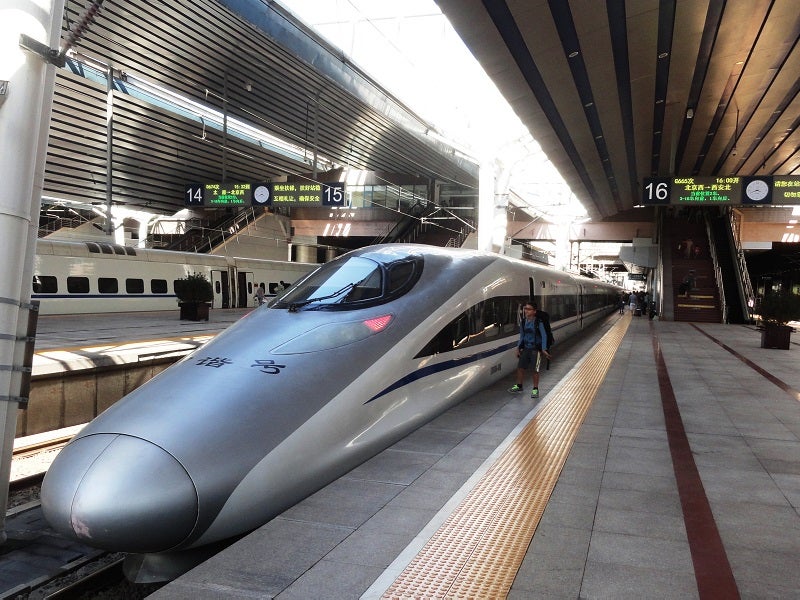
This December will mark the ten-year anniversary of the opening of the Wuhan–Guangzhou high-speed railway in China.
It represents a seminal moment in the country’s modern history. The 1,100km service marked China’s first foray into the world of high-speed rail; it has not looked back since.
While other countries have struggled to make HSR a reality, state-owned China Railway Corp (CRC) has busied itself in laying down over 25,000km of high-speed track over the last decade – accounting for roughly two-thirds of the world’s total length of HSR lines.
No nation comes close to rivalling China’s HSR construction story. According to a recent report published by The World Bank – which, itself, has financed around 2,600km of Chinese track – other countries would do well to follow Beijing’s example.
“China has built the largest high-speed rail network in the world,” said Martin Raiser, the World Bank’s country director for China.
“The impacts go well beyond the railway sector and include changed patterns of urban development, increases in tourism, and promotion of regional economic growth. Large numbers of people are now able to travel more easily and reliably than ever before, and the network has laid the groundwork for future reductions in greenhouse gas emissions.”
Forward thinking: long-term planning facilitates a competitive HSR network
One of the keys to China’s successful development of its HSR network has been long-term planning. The bank’s report cites the country’s Medium-and Long-Term Railway Plan – which looks up to 15 years ahead – as evidence of its farsightedness when it comes to high speed.
The report, titled “China’s High-Speed Rail Development”, also points to China’s success in making HSR competitive with road and air transport for distances up to around 1,200km. In doing so, train fares remain competitive with bus and air fares, enabling the network to attract 1.7 billion passengers a year from a broad cross-section of society and income groups.
What’s more, says the report, China has managed to build its high-speed network at an average cost of $17m-$21m per km – about two-thirds of the cost found in other countries. This cost-effectiveness is attributed to the standardisation of designs and procedures.
Then there are the economic benefits to consider. Estimated to stand at 8%, the rate of return for China’s HSR network is said to far outweigh the opportunity cost of capital in the country – and most other countries, for the matter. This all makes for copper-bottomed long-term infrastructure investments, says the bank.
Deep in debt: The price of debt financing HSR projects
In short, China’s HSR network is enviable on the surface. But deeper inspection also reveals infrastructure projects buckling under an enormous weight of debt.
The majority of China’s high-speed rail is reliant on debt financing, which led to CRC’s debt increasing almost tenfold from $70.70bn in 2005 to $4.72tn in 2016. This is part of a wider fiscal in trend, too – by the estimates of the Bank for International Settlements, China’s total debt hit $33.2tn at the close of 2018. Only the US has a larger national debt.
This has led some experts to speculate whether China’s unrelenting push for high-speed domination has come at a price: fiscal unviability, in which many lines look incapable of repaying the interest on their debt.
Speaking to the Financial Times last year, Professor Zhao Jian, of Beijing Jiaotong University, claimed CRC’s debts could climb by as much as 60% in the coming years.
“China Railways has always depended on financial subsidies and continues to raise new debt to pay off old debt,” said Zhao.“[This] will inevitably lead to a railway debt crisis.”
White elephants: projects put on hold make for a cautionary tale
There has also been noticeably slow progress made on recent projects, which bears witness to CRC’s debt issues. As reported in the South China Morning Post in July, the construction of a new high-speed link between Zhengzhou in Henan province and Jinan Shandong has hit the buffers due to funding issues.
As Beijing looks to reduce its spending and cut taxes – amid the trade war with the US – it seems unlikely that provincial governments will be given enough money to fund new projects.
Other lines, such as Lanzhou-Xinjiang route – which only operates eight daily services, despite being designed to handle 320 trains a day – are struggling to meet their electricity costs. The reality is that such lines are in danger of becoming white elephants.
Given its sheer size and the might of its economy, China also makes for a slightly tricky benchmark. For all its apparent benefits, China’s centrally planned model of HSR development would struggle to be adapted to many countries – particularly smaller nations.
“Countries with smaller populations will need to choose routes carefully and balance the wider economic and social benefits of improved connectivity against financial viability concerns,” read a recent press release from the World Bank.
China’s HSR development sits somewhere between a shining example of infrastructure planning and a cautionary tale of unsustainable government subsidising. For this reason, following its example is not necessarily a no-brainer.



